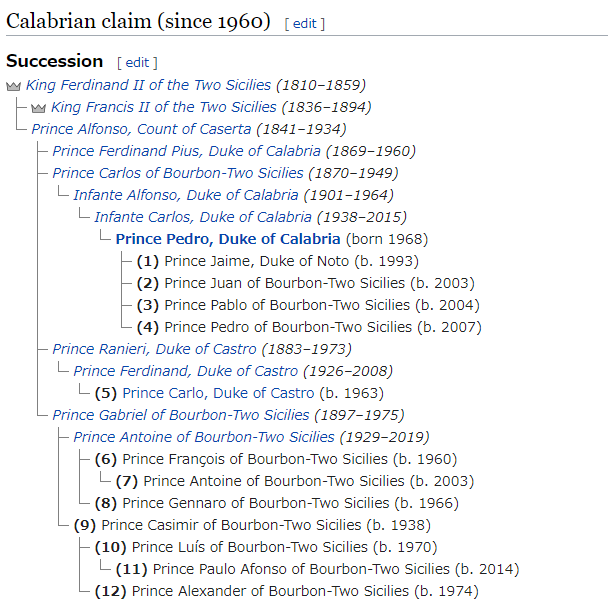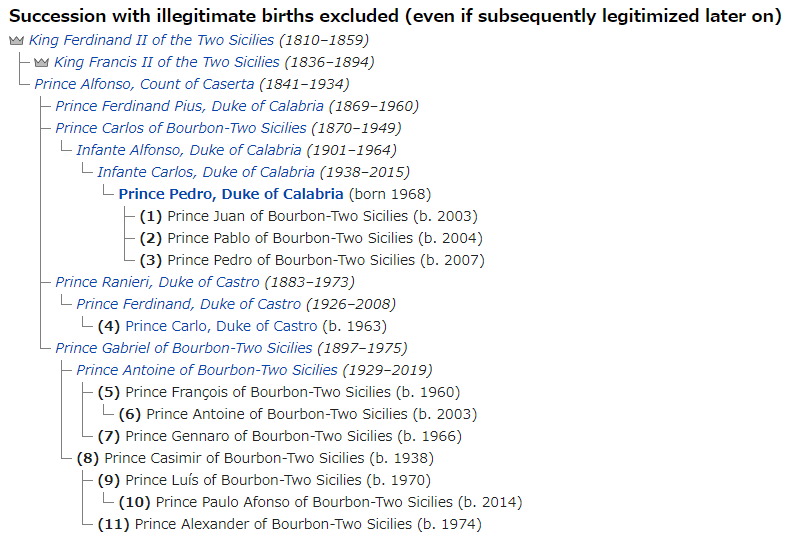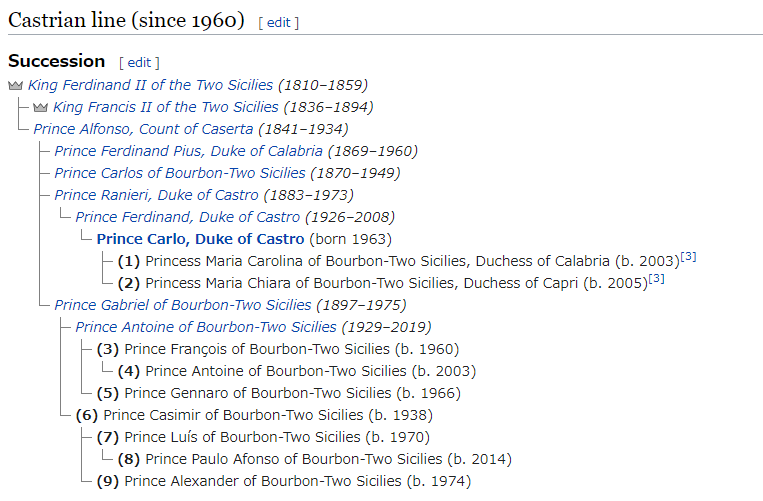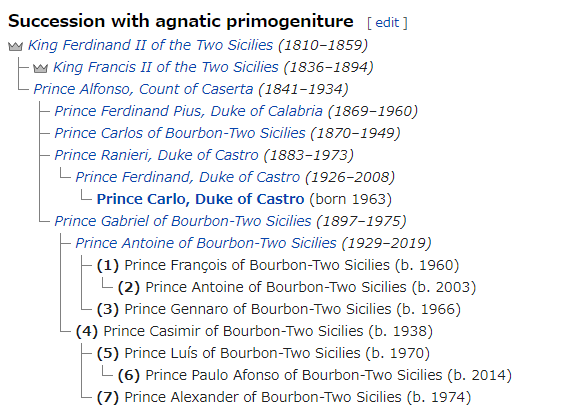This article based on the List of living legitimate male Capetians of Wikipedia’s article.
note:
As of August 2020.
See also:
Line of succession to the former Monarchical throne and others : From (deleted) Wikipedia’s articles.
The Capetian dynasty is the largest dynasty in Europe, with over 120 living male members descended in the legitimate agnatic line. Since the extinction of the House of Courtenay in 1733, the House of Bourbon is the only remaining branch of legitimate descent.
Descendants in the male line of Louis XIV through his grandson Philip V of Spain are designated as House of Bourbon; descendants in the male line of Philip I, Duke of Orléans, are designated as House of Orléans. All those listed below are actually descendants of King Louis XIII; after the death in 1830 of Louis Henry II, the last Prince of Condé (descended from the youngest son of Charles, Duke of Vendôme), no other legitimate lines of descent from Hugh Capet continued to exist.
Patrilineal descent
The Capetian lineage can be traced back more than 1,200 years and is one of the oldest in Europe. The dynasty achieved royal status either in 888, at the election of Odo (a Robertian) to the crown of France, or in 987, at the election of Hugh Capet, making it the oldest Western European royal dynasty in existence.[citation needed]
- Robert II of Worms and Rheingau, 770–807
- Robert III of Worms and Rheingau, 800–834
- Robert the Strong, Margrave of Neustria, 830–866
- Robert I, King of the Franks, 866–923
- Hugh the Great, Duke of the Franks, 898–956
- Hugh Capet, King of the Franks, 939–996
- Robert II, King of the Franks, 972–1031
- Henry I, King of the Franks, 1008–1060
- Philip I, King of the Franks, 1052–1108
- Louis VI, King of the Franks, 1081–1137
- Louis VII, King of the Franks, 1120–1180
- Philip II, King of France, 1165–1223
- Louis VIII, King of France, 1187–1226
- Louis IX, King of France, 1214–1270
- Robert, Count of Clermont, 1256–1317
- Louis I, Duke of Bourbon, 1279–1342
- James I, Count of La Marche, 1319–1362
- John I, Count of La Marche, 1344–1393
- Louis, Count of Vendôme, c. 1376–1446
- John II, Count of Vendôme, 1425–1477
- Francis, Count of Vendôme, 1470–1495
- Charles, Duke of Vendôme, 1489–1537
- Antoine, King of Navarre, 1518–1562
- Henry IV, King of France, 1553–1610
- Louis XIII, King of France, 1601–1643
Ancestral lines of the Bourbons
- Louis XIII, King of France (1601-1643)
- Louis XIV, King of France (1638-1715)
- Louis, Dauphin of France (1661-1711)
- Philip V, King of Spain (1683-1746)
- Charles III, King of Spain (1716-1788)
- Charles IV, King of Spain (1748-1819)
- Infante Francisco de Paula of Spain (1794-1865)
- Francisco de Asís, Duke of Cádiz (1822-1902)
- Alfonso XII, King of Spain (1857-1885)
- House of Bourbon
- House of Bourbon-Spain
- Enrique, 1st Duke of Seville (1823-1870)
- Francisco de Paula de Borbón y Castellví (1853-1942)
- Alberto, 1st Duke of Santa Elena (1854-1939)
- House of Bourbon-Santa Elena
- Ferdinand I, King of Two Sicilies (1751-1825)
- Francis I, King of Two Sicilies (1777-1830)
- Ferdinand II, King of Two Sicilies (1810-1859)
- Alfonso, Count of Caserta (1841-1934)
- House of Bourbon-Two Sicilies
- Philip I, Duke of Parma (1720-1765)
- Ferdinand I, Duke of Parma (1751-1802)
- Louis, King of Etruria (1773-1803)
- Charles II, Duke of Parma (1799-1883)
- Charles III, Duke of Parma (1823-1854)
- Philippe I, Duke of Orleans (1640-1701)
- Philippe II, Duke of Orleans (1674-1723)
- Louis IV, Duke of Orléans (1703-1752)
- Louis Philippe I, Duke of Orleans (1725-1785)
- Louis Philippe II, Duke of Orleans (1747-1793)
- Louis Philippe I, King of the French (1773-1850)
- Ferdinand, Duke of Orleans (1810-1842)
- Robert, Duke of Chartres (1840-1910)
- Louis, Duke of Nemours (1814-1896)
- Gaston, Count of Eu (1842-1922)
- House of Orléans-Braganza
- Antoine, Duke of Montpensier (1824-1890)
- Antonio, Duke of Galliera (1866-1934)
- House of Orléans-Galliera
Living Bourbon males born of Catholic marriages

House of Bourbon
- Alfonso XII of Spain (1857-1885), eighth-generation descendant of Louis XIII
- Alfonso XIII of Spain (1886-1941)
- Jaime, Duke of Segovia (1908-1975)
- Alfonso, Duke of Cadiz (1936-1989)
- Louis Alphonse de Bourbon, Duke of Anjou (Madrid 25.4.1974, aged 46), Aîné des Capétiens
- Louis de Bourbon, Duke of Burgundy (New York 28.5.2010, aged 10)
- Alphonse de Bourbon, Duke of Berry (New York 28.5.2010, aged 10)
- Henri de Bourbon, Duke of Touraine (New York 1.2.2019, aged 1)
House of Bourbon-Spain
- Alfonso XII of Spain (1857-1885)
- Alfonso XIII of Spain (1886-1941)
- Juan, Count of Barcelona (1913-1993)
- Juan Carlos I of Spain (Rome 5.1.1938, aged 82)
- Felipe VI, King of Spain (Madrid 30.1.1968, aged 52)
House of Bourbon-Seville
- Francisco de Paula de Borbón y Castellví (1853-1942), eighth-generation descendant of Louis XIII
- Francisco de Paula de Borbón y de la Torre, Duke of Seville (1882-1952)
- Francisco de Paula de Borbón y Borbón (1912-1995)
- Don Francisco de Borbón y Escasany, 5th Duke of Séville (Madrid 16.11.1943, aged 76)
- Don Francisco de Borbón y Hardenberg (Madrid 21.1.1979, aged 41)
- Don Alfonso Carlos de Borbón y Escasany (Madrid 10.2.1945, aged 75)
- Don Alfonso de Borbón y Yordi (Madrid 16.11.1973, aged 46)
- Don Enrique de Borbón y Garcia de Lobez (Madrid 18.3.1970, aged 50)
- Francisco de Paula de Borbón y Castellví (1853-1942)
- José de Borbón y La Torre (1883-1962)
- Carlos de Borbón y Rich (1915-1978)
- Don Carlos de Borbón y Oro (Ciempozuelos 26.6.1940, aged 80)
- Francisco de Paula de Borbón y Castellví (1853-1942)
- José de Borbón y La Torre (1883-1962)
- Alberto de Borbón y Rich (1916-1997)
- Enrique José de Borbón y Campos (Madrid 11.1.1948, aged 72)
Santa Elena branch
- Alberto María de Borbón y Castellvi, 1st Duke of Santa Elena (1854-1939), eighth-generation descendant of Louis XIII
- Alberto de Borbón y d’Ast, 2nd Duke of Santa Elena (1883-1959)
- Alfonso María de Borbón y Pintó, Marquess of Santa Fe de Guardiola (1909-1938)
- Alberto de Borbón y Perez del Pulgar, 3rd Duke of Santa Elena (1933-1995)
- Don Alfonso de Borbón y Sanchiz, 4th Duke of Santa Elena (Madrid 31.3.1961, aged 59)
- Don Alfonso de Borbón y Escrivá de Romani (Madrid 2.2.1995, aged 25)
- Alberto María de Borbón y Castellvi, 1st Duke of Santa Elena (1854-1939)
- Alberto de Borbón y d’Ast, 2nd Duke of Santa Elena (1883-1959)
- Alfonso María de Borbón y Pintó, Marquess of Santa Fe de Guardiola (1909-1938)
- Alfonso de Borbón y Perez del Pulgar (1937-2007)
- Alfonso de Borbón y Medina (1963-2005)
- Don Alfonso de Borbón y Pérez-Menzel (6.11.1999, aged 20)
- Don Fernando de Borbón y Medina (Seville 15.6.1966, aged 54)
- Fernando de Borbón y Vallejo (12.3.2001, aged 19)
- Ignacio de Borbón y Vallejo (12.10.2005, aged 14)
- Jamie Santiago de Borbón y Medina (Seville 19.7.1971, aged 49)
House of Bourbon-Two Sicilies
Calabria branch
- Alfonso, Count of Caserta (1841-1934), eighth-generation descendant of Louis XIII
- Carlos of Bourbon-Two Sicilies (1870-1949)
- Alfonso, Duke of Calabria (1901-1964)
- Carlos, Duke of Calabria (1938-2015),
- Prince Pedro of Bourbon-Two Sicilies, Duke of Calabria (Madrid 16.10.1968, aged 51)
- Prince Juan of Bourbon-Two Sicilies (Madrid 18.4.2003, aged 17)
- Prince Pablo of Bourbon-Two Sicilies (Madrid 28.6.2004, aged 16)
- Prince Pedro of Bourbon-Two Sicilies (Madrid 3.1.2007, aged 13)
Castro branch
- Alfonso, Count of Caserta (1841-1934)
- Ranieri, Duke of Castro (1883-1973)
- Ferdinand, Duke of Castro (1926-2008)
- Prince Carlo of Bourbon-Two Sicilies, Duke of Castro (St.Raphael 24.2.1963, aged 57)
- Alfonso, Count of Caserta (1841-1934)
- Filippo of Bourbon-Two Sicilies (1885-1949)
- Gaëtano of Bourbon-Two Sicilies (1917-1984)
- Adrian de Bourbon (Warrington 7.4.1948, aged 72)
- Philip de Bourbon (Harare 5.5.1977, aged 43)
- Gregory de Bourbon (Warrington 2.1.1950, aged 70)
- Christian de Bourbon (Vancouver 11.4.1974, aged 46)
- Raymond de Bourbon (Harare 8.11.1978, aged 41)
- Alfonso, Count of Caserta (1841-1934)
- Gabriel of Bourbon-Two Sicilies (1897-1975)
- Prince Antoine of Bourbon-Two Sicilies (1929-2019)
- Prince François of Bourbon-Two Sicilies (Ravensburg 20.6.1960, aged 60)
- Prince Antoine of Bourbon-Two Sicilies (Geneva 6.6.2003, aged 17)
- Prince Gennaro of Bourbon-Two Sicilies (Ravensburg 27.1.1966, aged 54)
- Alfonso, Count of Caserta (1841-1934)
- Gabriel of Bourbon-Two Sicilies (1897-1975)
- Prince Casimir of Bourbon-Two Sicilies (Warsaw 8.11.1938, aged 81)
- Prince Louis of Bourbon-Two Sicilies (Rio de Janeiro 28.11.1970, aged 49)
- Prince Paulo Afonso of Bourbon-Two Sicilies (2014, aged 6)
- Prince Alexander of Bourbon-Two Sicilies (São Paulo 9.8.1974, aged 45), priest
House of Bourbon-Parma
- Charles III, Duke of Parma (1823-1854), eighth-generation descendant of Louis XIII
- Robert I, Duke of Parma (1848-1907)
- Xavier, Duke of Parma (1889-1977)
- Carlos Hugo, Duke of Parma (1930-2010)
- Prince Carlos of Bourbon-Parma, Duke of Parma (Nijmegen 27.1.1970, aged 50)
- Carlos, Hereditary Prince of Bourbon-Parma (The Hague 24.4.2016, aged 4)
- Prince Jaime of Bourbon-Parma, Count of Bardi (Nijmegen 13.10.1972, aged 47)
- Prince Sixte Henri of Bourbon-Parma, Duke of Aranjuez (Pau 22.7.1940, aged 80)
Luxembourg branch
- Charles III, Duke of Parma (1823-1854)
- Robert I, Duke of Parma (1848-1907)
- Felix of Bourbon-Parma (1893-1970)
- Jean, Grand Duke of Luxembourg (1921-2019)
- Henri, Grand Duke of Luxembourg (Chat. Betzdorf 16.4.1955, aged 65)
- Guillaume, Hereditary Grand Duke of Luxembourg (Luxembourg 11.11.1981, aged 38)
- Prince Charles of Luxembourg (Luxembourg 10.5.2020, aged 0)
- Prince Félix of Luxembourg (Luxembourg 3.6.1984, aged 36)
- Prince Liam of Nassau (Geneva 28.11.2016, aged 3)
- Prince Louis of Luxembourg (Luxembourg 3.8.1986, aged 33)
- Prince Noah of Nassau (Luxembourg 21.9.2007, aged 12)
- Prince Sébastien of Luxembourg (Luxembourg 17.4.1992, aged 28)
- Prince Jean of Luxembourg (Chat. Betzdorf 15.5.1957, aged 63)
- Prince Constantin of Nassau (Paris 22.7.1988, aged 32)
- Prince Wenceslas of Nassau (Paris 17.11.1990, aged 29)
- Prince Carl-Johan of Nassau (Paris 15.8.1992, aged 27)
- Prince Guillaume of Luxembourg (Chat. Betzdorf 1.5.1963, aged 57)
- Prince Paul Louis of Nassau (Luxembourg 4.3.1998, aged 22)
- Prince Léopold of Nassau (Luxembourg 2.5.2000, aged 20)
- Prince Jean of Nassau (Luxembourg 13.7.2004, aged 16)
- Charles III, Duke of Parma (1823-1854)
- Robert I, Duke of Parma (1848-1907)
- Felix of Bourbon-Parma (1893-1970)
- Charles of Luxembourg (1927-1977)
- Prince Robert of Luxembourg (Fischbach 22.8.1968, aged 51)
- Prince Alexandre of Nassau (Aix-en-Provence 18.4.1997, aged 23)
- Prince Frederik of Nassau (Aix-en-Provence 18.3.2002, aged 18)
House of Bourbon-Parma
- Charles III, Duke of Parma (1823-1854)
- Robert I, Duke of Parma (1848-1907)
- René of Bourbon-Parma (1894-1962)
- Jacques of Bourbon-Parma (1922-1964)
- Prince Philippe of Bourbon-Parma (Copenhagen 22.1.1949, aged 71)
- Jacques of Bourbon-Parma (Roskilde 3.1.1986, aged 34)
- Joseph of Bourbon-Parma (Roskilde 6.6.1989, aged 31)
- Prince Alain of Bourbon-Parma (Roskilde 15.5.1955, aged 65)
- Charles III, Duke of Parma (1823-1854)
- Robert I, Duke of Parma (1848-1907)
- René of Bourbon-Parma (1894-1962)
- Michel of Bourbon-Parma (1926-2018)
- Prince Eric of Bourbon-Parma (Copenhagen 28.8.1953, aged 66)
- Prince Michel of Bourbon-Parma (Lejre 12.2.1989, aged 31)
- Prince Henri of Bourbon-Parma (Roskilde 14.10.1991, aged 28)
- Prince Charles Emmanuel of Bourbon-Parma (Paris 3.6.1961, aged 59)
- Prince Amaury of Bourbon-Parma (Paris 30.10.1991, aged 28)
- Charles III, Duke of Parma (1823-1854)
- Robert I, Duke of Parma (1848-1907)
- René of Bourbon-Parma (1894-1962)
- André of Bourbon-Parma (1928-2011)
- Axel of Bourbon-Parma (Paris 18.9.1967, aged 52)
- Côme of Bourbon-Parma (Neuilly 7.5.1997, aged 23)
- Charles III, Duke of Parma (1823-1854)
- Robert I, Duke of Parma (1848-1907)
- Luigi of Bourbon-Parma (1899-1967)
- Guy of Bourbon-Parma (1940-1991)
- Louis of Bourbon-Parma (Paris 25.6.1966, aged 54)
- Guy of Bourbon-Parma (Genolier, CH 6.2.1995, aged 25)
- Prince Rémy of Bourbon-Parma (Cannes 14.7.1942, aged 78)
- Tristan of Bourbon-Parma (Cannes 30.6.1974, aged 46)
- Prince Jean Bernard of Bourbon-Parma (Cannes 15.10.1961, aged 58)
- Arnaud de Bourbon (Cannes 26.10.1989, aged 30)
- Christophe de Bourbon (Mandelieu 4.7.1991, aged 29)
| All those listed above are descendants of Louis XIV, King of France
|
House of Orléans
- Robert, Duke of Chartres (1840-1910), eighth-generation descendant of Louis XIII
- Jean, Duke of Guise (1874-1940)
- Henri, Count of Paris (1908-1999)
- Henri d’Orléans, Count of Paris (1933-2019)
- Jean d’Orléans, Count of Paris (Boulogne-Billancourt 19.5.1965, aged 55)
- Prince Gaston d’Orléans (Paris 19.11.2009, aged 10)
- Prince Joseph d’Orléans (Dreux 2.6.2016, aged 4)
- Eudes d’Orléans, Duke of Angoulême (Paris 18.3.1968, aged 52)
- Prince Martin d’Orléans (Orleans 23.7.2004, aged 17)
- Robert, Duke of Chartres (1840-1910),
- Jean, Duke of Guise (1874-1940)
- Henri, Count of Paris (1908-1999)
- Michel d’Orléans, Count of Evreux (Rabat, Maroc 25.6.1941, aged 79)
- Charles Philippe d’Orléans, Duke of Anjou (Paris 3.3.1973, aged 47)
- Prince François d’Orléans, Count of Dreux (Madrid 10.2.1982, aged 38)
- Prince Philippe d’Orléans (12.5.2017, aged 3)
- Jacques d’Orléans, Duke of Orleans (Rabat, Maroc 25.6.1941, aged 79)
- Charles-Louis d’Orléans, Duke of Chartres (Neuilly-sur-Seine 11.7.1972, aged 48)
- Prince Philippe d’Orléans (Buenos Aires 3.11.1998, aged 21)
- Prince Constantin d’Orléans (Paris 15.2.2003, aged 17)
- Foulques d’Orléans, Duke of Aumale (Paris 9.7.1974, aged 46)
- Robert, Duke of Chartres (1840-1910)
- Jean, Duke of Guise (1874-1940)
- Henri, Count of Paris (1908-1999)
- Thibaut, Count of La Marche (1948-1983)
- Robert d’Orléans, Count of La Marche (Edinburgh 6.9.1976, aged 43)
House of Orléans-Braganza
Petrópolis branch
- Gaston, Count of Eu (1842-1922), eighth-generation descendant of Louis XIII
- Pedro de Alcântara, Prince of Grão-Pará (1875-1940)
- Pedro Gastão of Orléans-Braganza (1913-2007)
- Prince Pedro Carlos of Orléans-Braganza (Rio de Janeiro 31.10.1945, aged 74)
- Prince Pedro Thiago of Orléans-Braganza (Petropolis 12.1.1979, aged 41)
- Prince Filipe of Orléans-Braganza (Brasília 31.12.1982, aged 37)
- Prince Alfonso Duarte of Orléans-Braganza (Petrópolis 25.4.1948, aged 72)
- Prince Manoel Alvaro of Orléans-Braganza (Petropolis 17.6.1949, aged 71)
- Prince Manoel Alfonso of Orléans-Braganza (Sevilla 9.4.1981, aged 39)
- Prince Francisco Humberto of Orléans-Braganza (Petropolis 9.12.1956, aged 63)
- Prince Francisco Teodoro of Orléans-Braganza (Petropolis 25.9.1979, aged 40)
- Prince Gabriel of Orléans-Braganza (Petropolis 13.11.1989, aged 30)
- Gaston, Count of Eu (1842-1922)
- Pedro de Alcântara, Prince of Grão-Pará (1875-1940)
- João of Orléans-Braganza (1916-2005)
- Prince João Henrique of Orléans-Braganza (Rio de Janeiro 25.4.1954, aged 66)
- Prince João Felipe of Orléans-Braganza (Rio de Janeiro 27.11.1986, aged 33)
- Prince João Antônio of Orléans-Braganza (Singapore 21.6.2017, aged 3)
Vassouras branch
- Gaston, Count of Eu (1842-1922)
- Luís of Orléans-Braganza (1878-1920)
- Pedro Henrique of Orléans-Braganza (1909-1981)
- Prince Luiz of Orléans-Braganza (Mandelieu 6.6.1938, aged 82)
- Prince Eudes of Orléans-Braganza (Mandelieu 8.6.1939, aged 81)
- Luiz Filipe of Orléans-Braganza (Rio de Janeiro 3.4.1969, aged 51)
- Maximiliano of Orléans-Braganza (Rio de Janeiro 14.6.2012, aged 8)
- Prince Bertrand of Orléans-Braganza (Mandelieu 2.2.1941, aged 79)
- Prince Pedro de Alcântara of Orléans-Braganza (Petropolis 1.12.1945, aged 74)
- Gabriel of Orléans-Braganza (Rio de Janeiro 1.12.1980, aged 39)
- Gabriel of Orléans-Braganza (Rio de Janeiro 12.4.2013, aged 7)
- Prince Fernando of Orléans-Braganza (Petropolis 2.2.1948, aged 72)
- Prince Antonio of Orléans-Braganza (Rio de Janeiro 24.6.1950, aged 70)
- Prince Rafael of Orléans-Braganza (Rio de Janeiro 24.4.1986, aged 34)
- Prince Francisco of Orléans-Braganza (Jacarezinho 6.4.1955, aged 65)
- Prince Alberto of Orléans-Braganza (Jundiai do Sol 23.6.1957, aged 63)
- Pedro Alberto of Orléans-Braganza (Rio de Janeiro 31.5.1988, aged 32)
- Antonio of Orléans-Braganza (Rio de Janeiro 29.5.1997, aged 23)
House of Orléans-Galliera
- Antonio, Duke of Galliera (1866-1930), eighth-generation descendant of Louis XIII
- Alfonso, Duke of Galliera (1886-1975)
- Alvaro, Duke of Galliera (1910-1997)
- Alonso d’Orléans-Borbón (1941-1975)
- Alfonso de Orléans-Borbón, Duke of Galliera (Santa Cruz, Teneriffe 2.1.1968, aged 52)
- Don Alonso Juan de Orléans-Borbón (Paris 15.7.1994, aged 26)
- Don Alvaro de Orléans-Borbón (Santa Cruz, Teneriffe, 4.10.1969, aged 50)
- Don Aiden de Orléans-Borbón (Spain, 19.6.2009, aged 11)
- Don Alvaro Jaime de Orléans-Borbón (Rome 1.3.1947, aged 73)
- Don Andrea de Orléans-Borbón (Rome 9.7.1976, aged 44)
- Don Alois de Orléans-Borbón (Rome 24.3.1979, aged 41)
- Don Alonso de Orléans-Borbón (Madrid 23.3.2010, aged 10)
(In French, the list comes to 117 people)
| All those listed above are descendants of Louis XIII, King of France
|
Dynastic claims
According to the “Legitimist” faction of French royalists, all male descendants of Hugh Capet in the legitimate male line are dynasts of the Kingdom of France. According to them, the current heir to the French throne, if restored, is Louis Alphonse, Duke of Anjou.
Traditional “legitimacy” is based on the old rules that existed in the Ancien Régime of the Kingdom of France; civil marriages were then non-existent. Eudes de Orléans-Bragança (b. 1977) and his brother Guy de Orléans-Bragança (b. 1985), sons of Prince Eudes of Orléans-Braganza, were born of civil marriage only, since their father did not obtain an annulment for his first marriage.[citation needed] Consequently, they are regarded as illegitimate according to canon law. Legitimated children, born before their parents’ marriage, such as the eldest sons of the Duke of Noto and Louis de Luxembourg, were also excluded from the list.
According to the Orleanist faction of French royalists, the current heir to the French throne, if restored, is Jean d’Orléans, Count of Paris. They consider foreigners ineligible to inherit the French throne, or at least the line of descent from Philip V of Spain (who renounced the French throne). The Orleanist order of succession is limited to the senior line of the House of Orleans (the cadet branches of Orleans-Braganza and Orleans-Galliera, and the descendants of Philip V of Spain are considered foreigners). However, François d’Orléans, Count of Clermont, had been disinherited due to mental disability, and the branches of Michel d’Orléans, Count of Evreux and Jacques d’Orléans, Duke of Orleans (fraternal twins) are reversed according to “historical French primogeniture”.
Renunciations
The renunciations of rights to thrones have created rival claims and disputes among the existing branches of the House of Bourbon.
The first of these is the renunciation, in 1713, of Philip V of Spain, grandson of Louis XIV of France, of his rights to the French throne. Such renunciation is invalid under the fundamental laws of that kingdom; in France, the right of succession to the throne was considered an inalienable right, so that the king should always be the senior male descendant of Hugh Capet. Nevertheless, the act was of no practical value until the extinction of the male line of Louis XV of France, which did not occur until 1883. By then the monarchy was no more, and most of the remaining royalists supported the Count of Paris, descendant of Philippe I, Duke of Orléans, brother of Louis XIV.
Charles III of Spain ordained that the Kingdoms of Spain and Two Sicilies ought never to be united. In context, the semi-Salic law of succession then operated in Spain, with Two Sicilies as a secundogeniture if that throne is vacant. In 1900, Prince Carlos of Bourbon-Two Sicilies renounced his rights of succession to the throne of Two Sicilies, upon his marriage to Mercedes, Princess of Asturias. This made his children heirs presumptive to the Spanish throne. But Alfonso XII and his line pushed them farther down the line of succession, while the death of Ferdinand, Carlos’ elder brother, made them immediate heirs to the defunct throne of Two Sicilies. Carlos’ son Infante Alfonso, Duke of Calabria, reclaimed his rights, to which his uncle, Prince Ranieri, Duke of Castro, objected. The dispute is still unresolved; the Calabria claimant is supported by Spain, while the Castro claimant is supported by other royal houses and the other members of the House of Bourbon-Two Sicilies.
In 1908, Pedro de Alcântara, Prince of Grão-Pará, wished to marry Countess Elisabeth Dobržensky de Dobrženicz. Although a Bohemian noblewoman, she did not belong to a royal or reigning dynasty. The constitution of the Brazilian empire did not require dynasts to marry equally, but made the marriage of the heir to the throne dependent upon the Sovereign’s consent. The pretender to the throne was Pedro’s mother, who wanted her children to marry royalty, in order to increase the prospects of a restoration. As a result, he renounced his succession rights to the throne of Brazil. Thus the Vassouras branch, descendants of his younger brother, Prince Luís of Orléans-Braganza, became the heirs of the Brazilian monarchy. But in 1940, Prince Pedro Gastão of Orléans-Braganza, Pedro’s son, rejected his father’s renunciation and claimed the headship of the Brazilian Imperial House.
Other renunciations
- Infante Jaime, Duke of Segovia, renounced his rights to the Spanish throne for himself and his descendants in 1933 due to his deafness. In 1949, he retracted his renunciation of the throne of Spain, but in 1969, Don Jaime definitively renounced the Spanish succession in favour of his nephew, King Juan Carlos I of Spain, by petition of his son Alfonso de Borbón.
- Jean, Grand Duke of Luxembourg renounced the titles of the House of Bourbon-Parma for himself and his family in 1986[2] when his eldest son, then-Hereditary Grand Duke Henri married Maria-Theresa Mestre. The reason for this was that the Duke of Parma, Carlos Hugo, ruled the marriage unequal in 1981, as well as the marriage of Prince Jean of Luxembourg to Hélène Suzanna Vestur in 1987, for which he renounced his rights to Luxembourg in 1986.
- Prince Louis of Luxembourg, renounced his right of succession for himself and his heirs upon his morganatic marriage in 2006.




